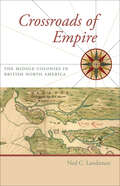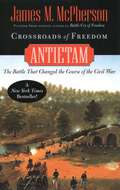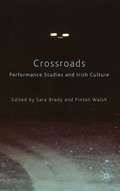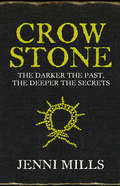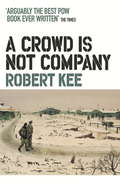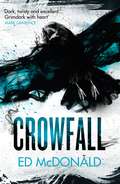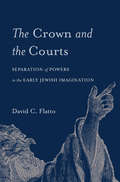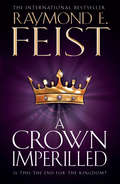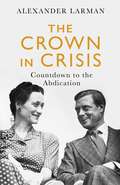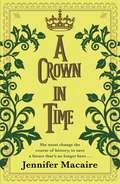- Table View
- List View
Crossroads of Empire: The Middle Colonies in British North America (Regional Perspectives on Early America)
by Ned C. LandsmanThis work examines the Middle Colonies—New York, New Jersey, and Pennsylvania—as a region at the center of imperial contests among competing European powers and Native American nations and at the fulcrum of an emerging British-Atlantic world of culture and trade.Ned C. Landsman traces the history of the Middle Colonies to address questions essential to understanding their role in the colonial era. He probes the concept of regionality and argues that while each territory possessed varying social, religious, and political cultures, the collective lands of New York, New Jersey, and Pennsylvania came to function as a region because of their particular history and their distinct place in the imperial and Atlantic worlds. Landsman demonstrates that the societal cohesiveness of the three colonies originated in the commercial and military rivalries among Native nations and developed further with the competing involvement of the European powers, eventually emerging as the focal point in the contest for dominion over North America. In relating this progression, Landsman discusses various factors in the region's development, including the Enlightenment, evangelical religion, factional politics, religious and ethnic diversity, and distinct systems of Protestant pluralism. Ultimately, he argues, it was within the Middle Colonies that the question was first posed, What is the American?An insightful and valuable classroom synthesis of the scholarship of the Middle Colonies, Crossroads of Empire makes clear the vital role of New York, New Jersey, and Pennsylvania in establishing an American identity.
Crossroads of Freedom: Antietam (Pivotal Moments in American History)
by James M. McPhersonThe Battle of Antietam, fought on September 17, 1862, was the bloodiest single day in American history, with more than 6,000 soldiers killed--four times the number lost on D-Day, and twice the number killed in the September 11th terrorist attacks. In Crossroads of Freedom, America's most eminent Civil War historian, James M. McPherson, paints a masterful account of this pivotal battle, the events that led up to it, and its aftermath. As McPherson shows, by September 1862 the survival of the United States was in doubt. The Union had suffered a string of defeats, and Robert E. Lee's army was in Maryland, poised to threaten Washington. The British government was openly talking of recognizing the Confederacy and brokering a peace between North and South. Northern armies and voters were demoralized. And Lincoln had shelved his proposed edict of emancipation months before, waiting for a victory that had not come--that some thought would never come. Both Confederate and Union troops knew the war was at a crossroads, that they were marching toward a decisive battle. It came along the ridges and in the woods and cornfields between Antietam Creek and the Potomac River. Valor, misjudgment, and astonishing coincidence all played a role in the outcome. McPherson vividly describes a day of savage fighting in locales that became forever famous--The Cornfield, the Dunkard Church, the West Woods, and Bloody Lane. Lee's battered army escaped to fight another day, but Antietam was a critical victory for the Union. It restored morale in the North and kept Lincoln's party in control of Congress. It crushed Confederate hopes of British intervention. And it freed Lincoln to deliver the Emancipation Proclamation, which instantly changed the character of the war. McPherson brilliantly weaves these strands of diplomatic, political, and military history into a compact, swift-moving narrative that shows why America's bloodiest day is, indeed, a turning point in our history.
Crossroads: Performance Studies and Irish Culture
by Sara Brady Fintan WalshThe highly performative categories of 'Irish culture' and 'Irishness' are in need of critical address, prompted by recent changes in Irish society, the arts industry and modes of critical inquiry. This book broaches this task by considering Irish expressive culture through some of the paradigms and vocabularies offered by performance studies.
The Crow Garden
by Alison LittlewoodSusan Hill meets Wilkie Collins in Alison Littlewood's latest chiller. Mad-doctor Nathaniel is obsessed with the beautiful Mrs Harleston - but is she truly delusional? Or is she hiding secrets that should never be uncovered . . . ?Haunted by his father's suicide, Nathaniel Kerner walks away from the highly prestigious life of a consultant to become a mad-doctor. He takes up a position at Crakethorne Asylum, but the proprietor is more interested in phrenology and his growing collection of skulls than the patients' minds. Nathaniel's only interesting case is Mrs Victoria Adelina - Vita - Harleston: her husband accuses her of hysteria and delusions - but she accuses him of hiding secrets far more terrible.Nathaniel is increasingly obsessed with Vita, but when he has her mesmerised, there are unexpected results. Vita starts hearing voices, the way she used to - her grandmother always claimed they came from beyond the grave - but it also unleashes her own powers of mesmerism . . . and a desperate need to escape.Increasingly besotted, Nathaniel finds himself caught up in a world of séances and stage mesmerism in his bid to find Vita and save her.But constantly hanging over him is this warning: that doctors are apt to catch the diseases with which they are surrounded - whether of the body or the mind . . .'[An] enjoyable excursion . . . gripping' The Sunday Times
Crow Stone
by Jenni MillsA compulsively readable thriller that skillfully weaves together past and present to uncover the sinister secrets buried in the ancient stone quarries under Bath.
Crowbone (The Oathsworn Series #5)
by Robert LowThe long awaited return to Robert Low’s Oathsworn series
Crowd Actions in Britain and France from the Middle Ages to the Modern World
by Michael T. DavisCrowd Actions in Britain and France from the Middle Ages to the Modern World explores the lively and often violent world of the crowd, examining some of the key flashpoints in the history of popular action. From the Peasants' Revolt of 1381 to the Paris riots in 2005 and 2006, this volume reveals what happens when people gather together in protest.
A Crowd Is Not Company (Phoenix Press Ser.)
by Robert KeeJournalist and broadcaster Robert Kee was an RAF bomber pilot in the Second World War. When his plane was shot down over Nazi-occupied Holland, he was captured and spent three years and three months in a German POW camp. From the beginning he was intent on escape. After several false starts, he finally made it. First published in 1947 as a novel, but now revealed to be an autobiography, A Crowd Is Not Company recounts Kee's experiences as a prisoner of war and describes in compelling detail his desperate journey across Poland - a journey that meant running the gauntlet of Nazism.
Crowds and Popular Politics in Early Modern England (Politics, Culture and Society in Early Modern Britain)
by John WalterEarly modern England was marked by profound changes in economy, society, politics and religion. It is widely believed that the poverty and discontent which these changes often caused resulted in major rebellion and frequent ‘riots’. Whereas the politics of the people have often been described as a ‘many-headed monster’; spasmodic and violent, and the only means by which the people could gain expression in a highly hierarchical society and a state that denied them a political voice, the essays in this collection argue for the inherently political nature of popular protest through a series of studies of acts of collective protest, up to and including the English Revolution. The work of John Walter has played a central role in defining current understanding of the field and has been widely read and cited by those working on the politics of subaltern groups. This collection of essays offers a radical re-evaluation of the nature of crowds and protests during the period, and it will make fascinating reading for historians of the period.
Crowds in Ireland, c.1720-1920
by P. Jupp E. MagennisAlthough the history of crowds in modern European history has been one of the most hotly debated subjects since E.P. Thompson's pioneering work of the 1960s, the crowd in Irish history has been largely neglected. This is the first study of the subject during the most turbulent period of Ireland's history. The introduction proposes an outline history of the crowd in Ireland and is followed by eight specialist studies of crowd activity by new and innovative scholars in the field. A special feature of the volume is that it incorporates discussions from a Colloquium held in Belfast in 1998 which was attended by the contributors and senior Irish and British historians.
Crowfall: The Raven's Mark Book Three (Raven's Mark #3)
by Ed McDonaldCrowfall is a gritty epic fantasy for fans of Mark Lawrence, Scott Lynch and Daniel Polansky.'Dark, twisty and excellent . . . Grimdark with heart' Mark LawrenceA sorcerous cataclysm has hit the Range, the final defensive line between the Republic and the immortal Deep Kings. Tormenting red rains sweep the land, new monstrosities feed on fear in the darkness, and the power of the Nameless, the gods who protect the Republic, lies broken. The Blackwing captains who serve them are being picked off one by one, and even immortals have learned what it means to die. Meanwhile the Deep Kings have only grown stronger, and are poised to deliver a blow that will finally end the war. Ryhalt Galharrow stands apart from it all.He has been deeper into the wasteland known as the Misery than ever before. It has grown within him - changed him - but all power comes with a price, and now the ghosts of his past, formerly confined to the Misery, walk with him everywhere.They will even follow him, and the few surviving Blackwing captains, on one final mission into the darkness.You think you know Misery? You've not seen anything yet . . .
The Crown: A Novel (Joanna Stafford #1)
by Nancy BilyeauFor secrets this deadly, blood will dye the throne of a nation... A superb Tudor novel from the author of THE CHALICE.London, May 1537. As those closest to the throne are locked in a fierce fight against those desperate to save England's monasteries from destruction, young Joanna Stafford faces a far more personal battle. When Joanna learns her cousin is about to be burned at the stake for rebelling against Henry VIII, she makes a decision that will change not only her life, but quite possibly the fate of a nation. It will mean turning her back on everything she knows, for Joanna is a novice at Dartford Priory - and to save her family, she must break the sacred rule of enclosure. But running away is only the first transgression. From the Tower of London, to secret assignations and from Stonehenge to the royal court - Joanna becomes entangled with a secret whose deadly past stretches farther back than anyone had imagined. As her mission draws a trail in blood from the last whispered words of a queen to a pattern of unnatural deaths in the royal lineage, Joanna must determine who to trust, and how far she's willing to go to protect her life, her family and everything she holds dear.
Crown and Country: A History Of England Through The Monarchy
by David StarkeyFrom one of our finest historians comes an outstanding exploration of the British monarchy from the retreat of the Romans up until the modern day. This compendium volume of two earlier books is fully revised and updated.
Crown and Nobility in Early Modern France (European History in Perspective)
by Donna BohananThis book analyses the evolving relationship between the French monarchy and the French nobility in the early modern period. New interpretations of the absolutist state in France have challenged the orthodox vision of the interaction between the crown and elite society. By focusing on the struggle of central government to control the periphery, Bohanan links the literature on collaboration, patronage and taxation with research on the social origins and structure of provincial nobilities. Three provinical examples, Provence, Dauphine and Brittany, illustrate the ways in which elites organised and mobilised by vertical ties (ties of dependency based on patronage) were co-opted or subverted by the crown.The monarchy's success in raising more money from these pays d'etats depended on its ability to juggle a set of different strategies, each conceived according to the particularity of the social, political and institutional context of the province. Bohanan shows that the strategies and expedients employed by the crown varied from province to province; conceived on an individual basis, they bear the signs of ad hoc responses rather than a gradnoise plan to centralise.
Crown and Nobility in Early Modern France (European History in Perspective)
by Donna BohananThis book analyses the evolving relationship between the French monarchy and the French nobility in the early modern period. New interpretations of the absolutist state in France have challenged the orthodox vision of the interaction between the crown and elite society. By focusing on the struggle of central government to control the periphery, Bohanan links the literature on collaboration, patronage and taxation with research on the social origins and structure of provincial nobilities. Three provinical examples, Provence, Dauphine and Brittany, illustrate the ways in which elites organised and mobilised by vertical ties (ties of dependency based on patronage) were co-opted or subverted by the crown.The monarchy's success in raising more money from these pays d'etats depended on its ability to juggle a set of different strategies, each conceived according to the particularity of the social, political and institutional context of the province. Bohanan shows that the strategies and expedients employed by the crown varied from province to province; conceived on an individual basis, they bear the signs of ad hoc responses rather than a gradnoise plan to centralise.
The Crown and the Courts: Separation Of Powers In The Early Jewish Imagination
by David C. FlattoA scholar of law and religion uncovers a surprising origin story behind the idea of the separation of powers.The separation of powers is a bedrock of modern constitutionalism, but striking antecedents were developed centuries earlier, by Jewish scholars and rabbis of antiquity. Attending carefully to their seminal works and the historical milieu, David Flatto shows how a foundation of democratic rule was contemplated and justified long before liberal democracy was born.During the formative Second Temple and early rabbinic eras (the fourth century BCE to the third century CE), Jewish thinkers had to confront the nature of legal authority from the standpoint of the disempowered. Jews struggled against the idea that a legal authority stemming from God could reside in the hands of an imperious ruler (even a hypothetical Judaic monarch). Instead scholars and rabbis argued that such authority lay with independent courts and the law itself. Over time, they proposed various permutations of this ideal. Many of these envisioned distinct juridical and political powers, with a supreme law demarcating the respective jurisdictions of each sphere. Flatto explores key Second Temple and rabbinic writings—the Qumran scrolls; the philosophy and history of Philo and Josephus; the Mishnah, Tosefta, Midrash, and Talmud—to uncover these transformative notions of governance.The Crown and the Courts argues that by proclaiming the supremacy of law in the absence of power, postbiblical thinkers emphasized the centrality of law in the people’s covenant with God, helping to revitalize Jewish life and establish allegiance to legal order. These scholars proved not only creative but also prescient. Their profound ideas about the autonomy of law reverberate to this day.
Crown, Church and Constitution: Popular Conservatism in England, 1815-1867 (Studies in British and Imperial History #4)
by Jörg NeuheiserMuch scholarship on nineteenth-century English workers has been devoted to the radical reform politics that powerfully unsettled the social order in the century’s first decades. Comparatively neglected have been the impetuous patriotism, royalism, and xenophobic anti-Catholicism that countless men and women demonstrated in the early Victorian period. This much-needed study of the era’s “conservatism from below” explores the role of religion in everyday culture and the Tories’ successful mobilization across class boundaries. Long before they were able to vote, large swathes of the lower classes embraced Britain’s monarchical, religious, and legal institutions in the defense of traditional English culture.
Crown, Church and Estates: Central European Politics in the Sixteenth and Seventeenth Centuries
by R. J. W. Evans T. V. ThomasThis book deals with a turning-point in European history: the dramatic struggle between the Protestant Reformation and the Catholic Counter-Reformation, and between princely rulers and landed nobles in sixteenth and seventeenth-century central and eastern Europe. It brings together the results of the latest research by leading scholars from North America and Europe and it throws new light on the victory of the Church and the rulers over Protestantism and the nobility which had such profound long-term consequences.
A Crown for Cold Silver: Book One of the Crimson Empire (Crimson Empire #1)
by Alex MarshallCold Cobalt, the Banshee with a Blade, First Among Villains . . . Queen ZosiaWhen there were no more titles to win and no more worlds to conquer, the warrior queen Zosia faked her demise and gave up her legend to history. But when violence finds its way to her door years later, she must round up her adventuring companions - each surprised to see her alive - and set out for revenge.Time has not been kind to her old comrades, and some have only their own goals in mind. Not only that, but there's a young, beautiful and skilled general out there, gathering soldiers to her banner for a war against the deadliest of enemies. The girl is using a legend she did not earn, and calling herself by a name that was never hers - that of Zosia herself.
Crown, Household and Parliament in Fifteenth Century England
by A. R. MyersA. R. Myers's research in the history of late medieval England spanned more than forty years. Throughout his academic career 15th-century England, especially the documentary remnants of its administration, held his attention consistently though not exclusively. The relevant studies, fruits of his research in this field which were originally published in periodicals published over five decades, have here been brought together. As a corpus they provide a collection of important documents related to the crown, the royal household and parliament. Complete with a critical introduction by R. B. Dobson, this is the essential collection of the works of an influential historian of early modern England.
A Crown Imperilled: Book Two Of The Chaoswar Saga (The Chaoswar Saga #2)
by Raymond E. FeistThe penultimate volume of the mighty Riftwar Cycle
Crown in Candlelight
by Rosemary Hawley JarmanKatherine of Valois, raised amidst the madness and lechery of the French court, wed to a conquering English king, Henry V, and now alone and afraid in a world of treachery and violence. Owen Tudor, incredibly handsome and gifted, a poet and singer by nature, a warrior by necessity, and now a man ready to risk life for love. Theirs was a passion too perilous to reveal and too fiery to be long restrained or concealed...
The Crown in Crisis: Countdown to the Abdication
by Alexander LarmanIn December 1936, Britain faced a constitutional crisis that was the gravest threat to the institution of the monarchy since the execution of Charles I. The ruling monarch, Edward VIII, wished to marry the American divorcée Wallis Simpson and crown her as his Queen. His actions scandalised the establishment, who were desperate to avoid an international embarrassment at a time when war seemed imminent. That the King was rumoured to have Nazi sympathies only strengthened their determination that he should be forced off the throne, by any means necessary. An influential coalition formed against him, including the Prime Minister Stanley Baldwin, his private secretary Alec Hardinge, the Archbishop of Canterbury and the editor of the Times. Betrayal and paranoia were everywhere, as MI5 bugged his telephone and his courtiers turned against him. Edward seemed fated to give up Wallis and remain a reluctant ruler, or to abdicate his throne. Yet he had his own supporters, too, including Winston Churchill, the Machiavellian newspaper proprietor Lord Beaverbrook and his brilliant adviser Walter Monckton. They offered him the chance to remain on the throne and keep Wallis. But was the price they asked too high? And what really lay behind the assassination attempt on Edward earlier that year? Using previously unpublished and rare archival material, and new interviews with those who knew Edward and Wallis, The Crown in Crisis is the conclusive exploration of how an unthinkable and unprecedented event tore the country apart, as its monarch prized his personal happiness above all else. This seismic event has been written about before but never with the ticking-clock suspense and pace of the thriller that it undoubtedly was for all of its participants. The Crown in Crisis is the definitive book about the events of 1936. Painstakingly researched, incisively written and entirely fresh in its approach, it will bring the events of that time to thrilling life, and in the process appeal to an entirely new audience.
Crown in Darkness (Hugh Corbett Mysteries, Book 2): A gripping medieval mystery of the Scottish court
by Paul DohertyHugh Corbett is drawn into the dangerous disputes for the Scottish throne...Crown in Darkness is the second gripping novel of murder and mayhem in Paul Doherty's acclaimed Hugh Corbett series. Perfect for fans of Robin Hobb and Michael Jecks.1286 and on a storm-ridden night King Alexander III of Scotland is riding across the Firth of Forth to meet his beautiful French bride Yolande. He never reaches his final destination as his horse mysteriously slips, sending them both crashing to their death on cruel rocks. The Scottish throne is left vacant of any real heir and immediately the great European princes and the powerful nobles of Alexander's kingdom start fighting for the glittering prize.The Chancellor of England, Burnell, ever mindful of the interest his king, Edward I, has in Scotland, sends his faithful clerk, Hugh Corbett, to report on the chaotic situation at the Scottish court. Concerned that a connection exists between the king's death and those now desirous of taking the Scottish throne, Corbett is drawn into a maelstrom of intrigue, conspiracy and danger. Will Corbett be able to discover the truth behind the King's death?What readers are saying about Paul Doherty:'A joy to read''[Paul Doherty] never lets the reader down''Five stars'
A Crown in Time: She must rewrite history, or be erased from Time forever... (The Tempus U Time Travel series #1)
by Jennifer MacaireSince it was perfected in 2900, time travel has been reserved for an elite, highly trained few. However, on certain occasions, a Corrector is needed to rectify a mistake in the past.Do your job well, and you'll go down in history. Fail, and you will be erased from Time . . .For fans of Jodi Taylor, the first in an exciting new time-slip series, from author of the action-packed Time for Alexander series, Jennifer Macaire. A CROWN IN TIME will have you on the edge of your seat from the very first page . . .In the far future, a convicted criminal is given a chance at redemption. The Corrector Program at Tempus University is sending Isobel back in time, to the year 1270, to rewrite history.Her mission? To save the crown of France.If she follows the Corrector's Handbook everything should run smoothly. But soon, Isobel finds herself accompanying a hot-headed young noble on his way to fight the infidel in Tunis: a battle Isobel knows is fated to be lost.Isobel must fulfil her duty, knowing she can never return to her time, knowing one wrong move can doom the future, or doom her to be burned as a witch . . .Praise for Jennifer Macaire's Alexander series:'Fascinating . . . jam-packed with adventure and colour.' Jodi Taylor
